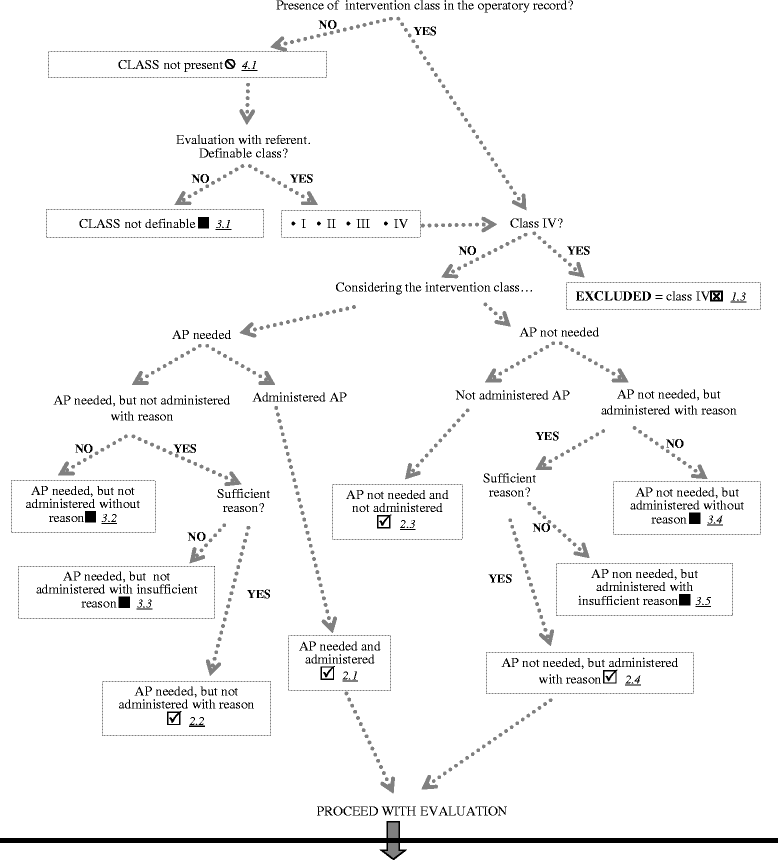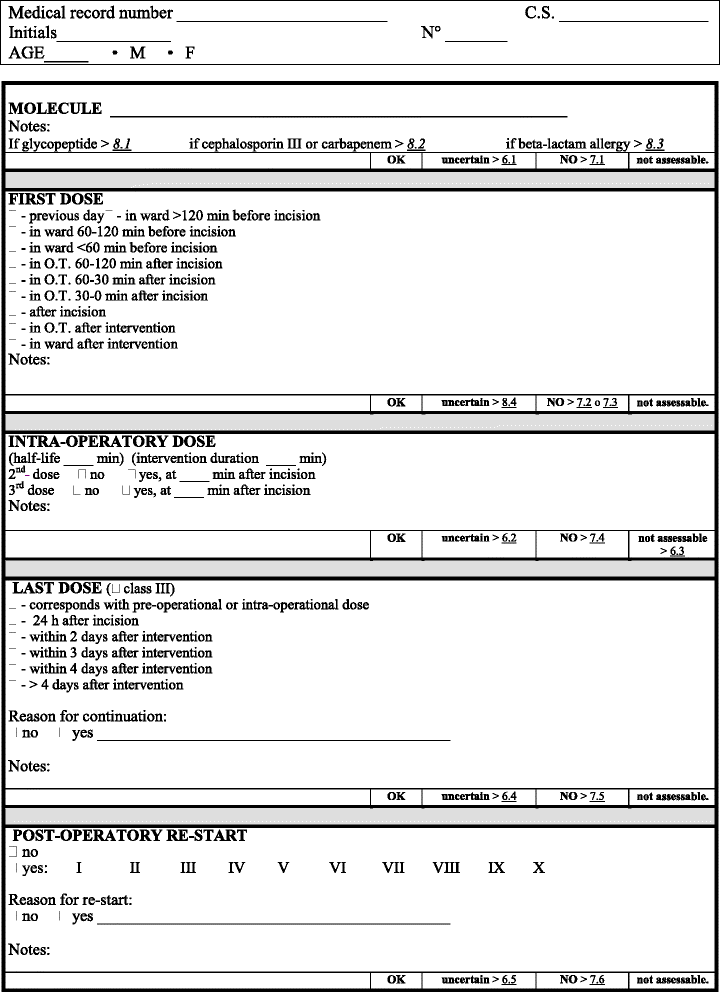Appropriate use of antimicrobial prophylaxis: an observational study in 21 surgical wards
- PMID: 25968324
- PMCID: PMC4434534
- DOI: 10.1186/s12893-015-0048-7
Appropriate use of antimicrobial prophylaxis: an observational study in 21 surgical wards
Abstract
Background: Surveillance of Surgical Site Infections (SSI) in 2010 found 39 % compliance with hospital guidelines in Piedmont (Italy). The aim of the study was to estimate the appropriate use of antimicrobial prophylaxis and compliance with hospitals guidelines in surgical wards.
Methods: This survey study took place in 21 surgery wards of 4 public hospitals. Forms were completed by public health resident doctors together with a medical ward referent and infection control nurses. 15 consecutive surgical procedures were randomly chosen from each ward. A total of 320 cases were analyzed. The study period was from July 2012 to January 2013. Data were collected using a survey form. A final score variable from 0 to 4 was given to each case. The results were compared with hospital and international guidelines. Data were analyzed using Epi-Info software.
Results: Of the 320 cases collected, 63 were excluded; of the remaining 257 cases, 56.4 % of the procedures were appropriate (score 4), 15.2 % were acceptable and 28.4 % were not acceptable. The study found an unjustified continuation of antimicrobial prophylaxis in 17.1 % of the 257 cases, an unjustified re-start of antimicrobial therapy in 9.7 % and a re-dosing omission in 7.8 %.
Conclusions: The study demonstrated critical problems in antimicrobial prophylaxis management in surgical wards due to a lack of compliance between hospitals and national guidelines, a shortage of specific and updated recommendations for some surgical interventions and incorrect local specific procedures. Coordination between local and national recommendations, strengthening of evidence based decisions and continuous sharing of policy updates are needed.
Figures
Similar articles
-
Risk of surgical site infection in older patients in a cohort survey: targets for quality improvement in antibiotic prophylaxis.Int Surg. 2015 Mar;100(3):473-9. doi: 10.9738/INTSURG-D-14-00042.1. Int Surg. 2015. PMID: 25785330 Free PMC article.
-
Adherence to international antimicrobial prophylaxis guidelines in cardiac surgery: a Jordanian study demonstrates need for quality improvement.J Manag Care Pharm. 2009 Apr;15(3):262-71. doi: 10.18553/jmcp.2009.15.3.262. J Manag Care Pharm. 2009. PMID: 19326957 Free PMC article.
-
Antibiotic prophylaxis adequacy in knee arthroplasty and surgical wound infection: Prospective cohort study.Rev Esp Cir Ortop Traumatol. 2017 Jul-Aug;61(4):259-264. doi: 10.1016/j.recot.2017.04.001. Epub 2017 Jun 20. Rev Esp Cir Ortop Traumatol. 2017. PMID: 28645839 Clinical Trial. English, Spanish.
-
Comparison of guideline recommendations for antimicrobial prophylaxis in urologic procedures: variability, lack of consensus, and contradictions.Int Urol Nephrol. 2018 Nov;50(11):1923-1937. doi: 10.1007/s11255-018-1971-1. Epub 2018 Aug 25. Int Urol Nephrol. 2018. PMID: 30145652 Review.
-
[Surgical site infections in Italy].Infez Med. 2009 Dec;17(4):205-18. Infez Med. 2009. PMID: 20046101 Review. Italian.
Cited by
-
Improving surgical antibiotic prophylaxis adherence and reducing hospital readmissions: a bundle of interventions including health information technologies.Eur J Hosp Pharm. 2020 Jul;27(4):237-242. doi: 10.1136/ejhpharm-2018-001666. Epub 2018 Nov 26. Eur J Hosp Pharm. 2020. PMID: 32587084 Free PMC article.
-
Antibiotic prophylaxis compliance differences in surgery and gynecology/obstetrics services in Huánuco, Peru.Infez Med. 2023 Sep 1;31(3):364-373. doi: 10.53854/liim-3103-10. eCollection 2023. Infez Med. 2023. PMID: 37701388 Free PMC article.
-
Antibiotic prophylaxis for surgical procedures: a scoping review.Rev Panam Salud Publica. 2021 May 26;45:e62. doi: 10.26633/RPSP.2021.62. eCollection 2021. Rev Panam Salud Publica. 2021. PMID: 34054932 Free PMC article.
-
Antibiotic use among older adults on an acute care general surgery service.Can J Surg. 2017 Dec;60(6):388-393. doi: 10.1503/cjs.004317. Can J Surg. 2017. PMID: 28930045 Free PMC article.
-
Diagnose-Specific Antibiotic Prescribing Patterns at Otorhinolaryngology Inpatient Departments of Two Private Sector Healthcare Facilities in Central India: A Five-Year Observational Study.Int J Environ Res Public Health. 2019 Oct 23;16(21):4074. doi: 10.3390/ijerph16214074. Int J Environ Res Public Health. 2019. PMID: 31652748 Free PMC article.
References
-
- European Centre for Disease Prevention and Control . Surveillance of surgical site infections in Europe 2008–2009. ECDC: Stockholm; 2012.
-
- ASSR Emilia Romagna . Sorveglianza delle infezioni del sito chirurgico in Italia. Interventi ortopedici anno 2010. Interventi non ortopedici anno 2011. Bologna: ASSR Emilia Romagna; 2012.
-
- Castella A, Argentero PA, Farina EC, Charrier L, Del Prever EM, Zotti CM, et al. Incidence of surgical-site infections in orthopaedic surgery: a Northern Italian experience. Epidemiol Infect. 2010;12:1–6. - PubMed
Publication types
MeSH terms
Substances
LinkOut - more resources
Full Text Sources
Other Literature Sources





